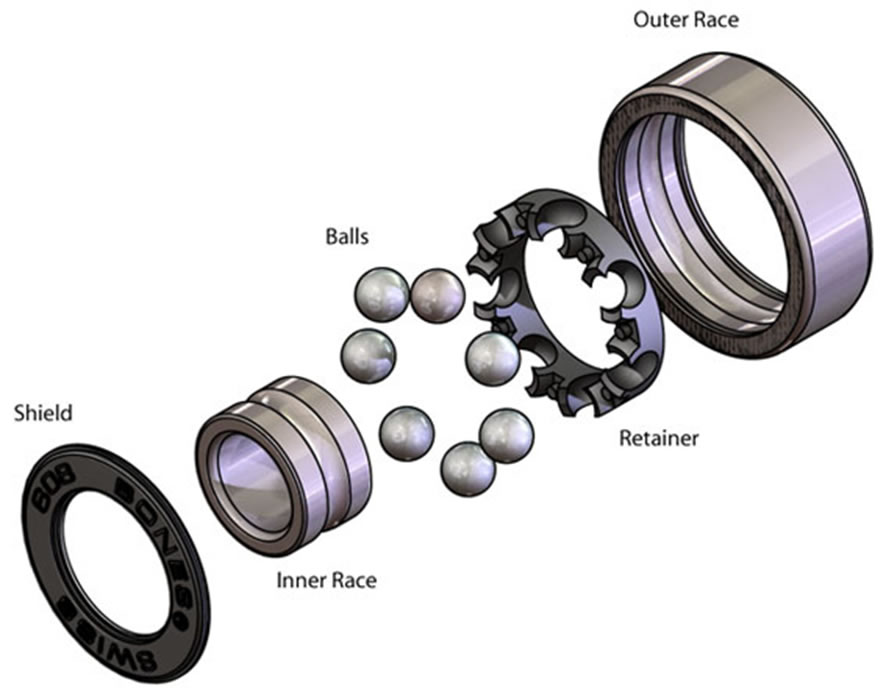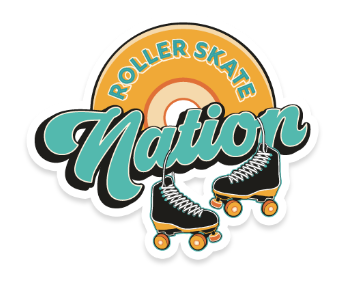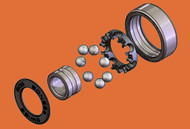Everything You Need to Know About Roller Skate Wheel Bearings
What are roller skate bearings?
Roller skate wheel bearings sit inside the wheel hub and are what allows the wheels to roll. Each wheel has two bearings in it; so how many bearings do you need for a pair of quad roller skates? You need 16 bearings in total.
In the past bearings were always rated on an ABEC rating scale, and many still are. ABEC ratings were designed for high speed applications like high speed motors and precision measuring instruments. Now, most bearings are considered above the ABEC rating scale. The result is many bearings made today are not rated on an ABEC scale. Bearings rated on an ABEC scale are not "better" than bearings not rated on an ABEC scale.
A higher rated bearing will NOT make you “go faster”, but the quality of a bearing does affect your roll out. The roll out is how long your wheels will continue spinning after you push off. A better bearing will keep you rolling longer, so you can put in less effort to cover the same amount of space.
In the past roller skate wheel bearings were actually put in by the skater with loose balls. This is very rare now. All ball bearings for roller skates made today come put together and have the same 5 components. So how do bearings work? Read about them below.

The 5 components of a bearing:
Shield:
The shield protects the contents of the bearing from debris. Some bearings will have a shield on each side of the bearing, and some will only have a shield on one side. If your bearings only have a shield on one side, always face the shield outward and the open side of the bearing toward the wheel hub. This will help keep them as clean as possible.
Shields are either metal or nylon. Shields made of metal are sometimes sealed, which means the bearing cannot be opened. This makes it difficult to maintain the bearing through proper cleaning and lubrication. Usually shields that are sealed are only found on lower priced bearings that are not intended for long term use. Some metal bearings will have a shield on just one side so that they can be cleaned, or a removable metal shield on one or both sides. The down fall of metal shields is they can get bent when maintaining your bearings, and once that shield bends and gets in the path of the balls it can slow down the roll of your wheels. Most bearings will have a removable nylon shield allowing the bearings to be opened for performing maintenance. Ideally a nylon shield on each side of the bearing will keep it the cleanest and make it the easiest to maintain.
Inner race:
The inner race is the only part of the bearing that comes in more than one size; 7mm or 8mm. What size you need is determined by what size axle you will be putting the bearing/wheel on. Most axles made recently will be 8mm, with older versions being primarily 7mm.
Balls:
The balls are what gives the bearing movement
Retainer:
The retainer keeps the balls from coming out of the bearing if the shield is removed.
Outer race:
The outer race is the outside of the bearing, and what is actually making contact with the wheel once installed.
What size bearing do I need?
Many incorrectly assume that your wheels determine your bearing size. In reality, the size of the axles on your skates determine which size bearings you need. Axles are commonly available in two sizes, 7mm (9/32) or 8mm (5/16). Most current skates are manufactured with an 8mm axle because 8mm bearings and locknuts are more common and readily available, however some high end plates (Labeda Proline, Sure-Grip Power-Trac, Sure-Grip Snyder and Roll Line) still use an 7mm axle.
If you are unsure which size axles are on your skates, you can tell by checking the bearings you currently have to see if they are 7mm or 8mm.
There are 3 very easy ways to check the roller skate bearing size you have.
- Look at the stamping on the shield of your existing skate bearing. Most will be stamped with 608. This means you have 8mm. If stamped with 627, you have a 7mm bearing.
- You can also tell by the size of the wheel nut. A 9/32" nut will indicate a 7mm bearing. A 5/16" nut will indicate a 8mm bearing.
- Take a number 2 pencil using the eraser side of the pencil. Try sliding the bearing onto the pencil. If it is too big to fit through the center it is a 7mm bearing, but if the same pencil slides right through you have a 8mm bearing.
How do I clean and lubricate my bearings?
In order to keep your bearings spinning freely and lasting longer, they must be maintained on a regular basis. Cleaning and lubricating are not the same thing. There are bearing cleaners and bearing lubricators, and it is important to be aware of the difference.
Bearings must be cleaned first and lubricated second. Why? If you lubricate your bearings before cleaning them, it will trap dirt and particles. Those particles are what destroy bearings.
Use Bearing Cleaner specifically formulated for bearings to get them sufficiently clean. If you do not have bearing cleaner, we recommend Mineral Spirits which are available at any home improvement, paint or hardware store.
If the bearings are extremely dirty, the bearings should be washed/agitated in the cleaner several times until the liquid is no longer dirty.
Its very important to make sure the bearings are 100% dry before applying the lubricant and installing the shields. The heavier the lubricant the longer it will last, and you won't have to clean and lube your bearings as often. An example of a heavy lubricant is Bones Speed Cream.
When your bearings no longer spin freely and quietly, it’s time to replace them.
Browse our available roller skate lubrication and cleaners.
When do I need to replace my bearings?
If your bearings have become rusted, are noisy when they spin, or are caked with grime even after cleaning, you will want to replace them. Bearings should always spin freely and quietly and be free of grime or rust.
What are the benefits of ceramic and Swiss bearings?
The benefits of ceramic or Swiss bearings are that they do not rust, and have been known to last upward of 20 years. They are self cleaning, are much lighter than metal bearings and are more durable. They also can withstand higher speeds & acceleration capability. With ceramic bearings there is less heat friction, and they have a higher spin rate. We recommend ceramic or Swiss bearings for advanced skaters that require durability and quality in a skate bearing, and are willing to invest in order to get long term use out of their bearings.


